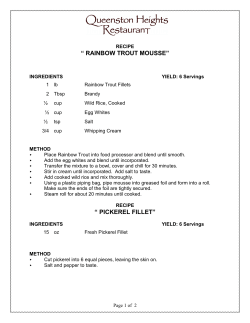
conducted on the 26
July, August, September 2013 Beaver Tailwater Annual Population Sample - The annual population sample on Beaver Tailwater (BVTW) was conducted on the 26th of September, 2013 by the Trout Management Program (TMP) and District 1-Fisheries personnel. Although the data from this sample has not been analyzed, a few preliminary observations can be made. A total of 542 rainbow trout were collected during the sample. Overall, catch rates of rainbow trout in September 2013 (180 trout/h) were similar to levels observed from 2007 to 2012 (range 157-182 trout/h). The average length of rainbow trout collected in 2013 (11.4 inches) was similar to rainbow trout collected in 2012 (11.6 inches). A total of 418 brown trout were also collected during the sample. Overall, catch rates of brown trout in September 2013 (139 trout/h) were much higher than during samples conducted from 2009-2012 (range 28-65 trout/h). Most likely, this can be attributed to the fact that the 2013 stocking of brown trout occurred in August, instead of in November or December like in previous years. Not including brown trout stocked in August, the overall catch rate was 86 trout/h. The average length of brown trout collected in 2013 (9.9 inches) was lower than in September 2012 (12.8 inches). The mean length of all brown trout, not including fish stocked in August, was 11.8 inches. More results from this sample will be provided in upcoming newsletters. Fingerling Trout Evaluation - Since June, the Trout Management Program has continued its efforts aimed at evaluating the performance of fingerling rainbow trout stocked into Beaver Tailwater. Approximately 8,000 McConaughy strain and 8,000 Shasta strain rainbow trout fingerlings were marked and stocked in July 2012. During the last sample (on July 31 st), we collected 15 McConaughy strain individuals which averaged 10.2 inches inches; no domestic strain individuals were collected during the sample. One domestic strain (~10.2 inches) and 22 McConaughy strain individuals (average 11.1 inches) were collected during the annual population sample in September. Overall, the two strains have increased approximately 6.7 and 7.7 inches since they were stocked in July 2012. Further sampling will be required to estimate approximate rates of survival and growth exhibited by these fingerling cohorts and whether those rates differ between strains. Bull Shoals & Norfork Tailwaters Minimum Flow Implementation – The big news on Bull Shoals and Norfork Tailwaters over the last few months has been the implementation of minimum flow from these dams. On July 1st, 2013 minimum flow was initiated on Bull Shoals. The additional release of 590 cubic feet per second (cfs) through one of the existing turbines combined with the existing flow from the house turbine and dam leakage (210 cfs) will result in a target minimum flow of 800 cfs when water is not being released for hydropower or flood control operations. At Norfork, the additional 185 cfs for minimum flow could not be released an existing turbine without damage to the unit. Therefore, a siphon tube was constructed through the dam to deliver this release. This volume coupled with existing flows from the house unit, leakage, and the Norfork National Fish Hatchery will provide an overall target flow of 300 cfs. The primary benefit from minimum flow will be an increase in continually wetted area, which will provide not only additional habitat for trout but also the aquatic invertebrates and sculpin that the trout feed on. Ultimately this should result in better growth and condition for the trout. The minimum flow release from Bull Shoals Dam should help to alleviate occasional high water temperatures in the reach between the Buffalo River and the Norfork Tailwater. Greers Ferry Tailwater Brown Trout Growth & Survival Study - During the third quarter of this year, the Trout Management Program and District-10 Fisheries continued work on a tagging study aimed at estimating the growth and survival of brown trout in the Little Red River. Since January of this year over 1,300 brown trout have been tagged in two different sections of the river; JFK Park Beech Island and the bottom of Mossy Special Regulations Area – Dripping Springs. Although high water foiled sampling efforts at the lower site early in the year, crews were able to tag fish in both areas at the end of last month. The external tags are inserted on the fish’s left side next to the dorsal fin and are printed with a 5-digit identification number and the Trout Management Program’s phone number. If an angler catches a tagged brown trout and harvest it, they are asked to call in the tag number along with the date, time, and location of the catch. If an angler catches a tagged brown trout but intend to release it, they are asked to please write down the tag number and call it in but not to remove the tag. The cooperation of anglers in this study is greatly appreciated. The information gained in this study will aid in evaluating the current brown trout regulations as we revisit the Little Red River management plan next year. Sculpin Sampling - Sampling took place on August 14, 2013 on Greers Ferry Tailwater to monitor the distribution of introduced sculpin. A pre-positioned shocker was placed on the river bottom in shoal areas at JFK SRA, Beech Island, Old Cow Shoals, New Cow Shoals and Jon’s Pocket. A total of 31 sculpin were collected resulting in a catch rate of 218 fish/hr. This is higher than what was observed during the 2012 sample (42 fish/hr). During our routine boat electrofishing samples we have observed sculpin in higher densities throughout the upper sections of the tailwater. Greers Ferry Tailwater Creel Survey – The creel survey currently being conducted on Greers Ferry Tailwater will continue through November 2013. The creel clerk, Alice McCutcheon, has been interviewing anglers to determine angler catch, harvest, demographics, and satisfaction. The Civil Air Patrol has been conducting aerial angler counts by flying up and down the river and counting the number of anglers to determine fishing pressure along the river. However, due to the recent government shutdown the creel flights have been suspended and will likely not resume until the shutdown has ended. Collins Creek – An annual population sample was conducted Collins Creek on August 15, 2013. During the sample we collected and measured 668 brown trout (328 trout/hr), 99 rainbow trout (49 trout/hr), and 1 brook trout (0.5 trout/hr). The proportion of brown trout in Collins Creek has continued to increase since 2002 (Figure 1). The mean total length of brown trout was 2.9 inches and rainbow trout had a mean total length of 2.8 inches. The one brook trout that was collected in the Lower section of the creek was 6.9 inches long. Collins Creek Brown Rainbow Brook 100% 80% 60% 40% 20% 0% 2002 2003 2004 2005 2006 2007 2008 2011 2012 2013 Figure 1. Percent of total catch of brown trout, rainbow trout and brook trout on Collins Creek, Heber Springs, AR from 2002-2013. Spring River Spring River Creel Survey - The first creel survey ever to be conducted on Spring River concluded in November 2012. Since then, the TMP has been analyzing data from the creel survey. Compared to other trout waters in Arkansas, the coldwater zone of the Spring River had more fishing pressure/mile/year than all but the Norfork and Greers Ferry Tailwaters (Table 1). Additionally, the Spring River had a higher percentage (52%) of nonresident anglers than Beaver Tailwater (17%), Greers Ferry Tailwater (27%), Bull Shoals and Norfork Tailwater (43%), and Narrows Tailwater (35%). Overall, 83% of anglers used only spinning/spincast/baitcast gear and 12% used fly fishing gear. The remaining 5% of anglers used a combination of both spinning and fly fishing gear during their fishing trip. Throughout the creel survey, 25% of anglers used only artificial lures/flies while fishing the Spring River. On Spring River, 57% of anglers used only bait, and 18% of anglers used a combination of artificial lures and bait while fishing. Overall, the percent of anglers who used bait on Spring River (57%) was higher than what was observed on Bull Shoals Tailwater (31%), Greers Ferry Tailwater (44%), and Narrows Tailwater 31%; Table 2). A follow-up mail survey was sent to anglers that were interviewed during the creel survey. Anglers were asked more in-depth questions on fishing satisfaction, catch and harvest preferences, their views on Spring River regulations, and aquatic nuisance species. So far, 63% of the delivered mail surveys have been returned and we will be soon looking at analyzing and reporting on this data. Data from the creel survey, mail survey, growth and survival study, and annual population samples will aid in the development of a management plan for the Spring River. We will be seeking stakeholder input during public meetings to help with the management plan process Table 1. Mean annual effort (angler hours) and pressure (angler hours/mi/yr) observed during recent Araknsas Tailwater creel surveys. Effort and pressure estimates for Narrows tailwater are for the colwater zone only. Trout Water Norfork TW Greers Ferry TW Spring River (coldwater) Beaver TW Bull Shoals TW Spring River Narrows TW Creel Survey Year(s) 2006-07 2004-06 Mean Effort 184,877 549,119 Pressure (Angler hours/mi/yr) 41,084 18,004 2010-12 2008-10 2006-07 2010-12 2006-08 161,372 81,164 1,091,339 172,171 34,445 13,707 12,224 11,862 10,575 4,732 Table 2. Comparison of overall percent use of gear types and terminal tackle during recent Arkansas tailwater creel surveys. Terminal Tackle Use Gear Use Creel Survey Location and Dates Spring River 2011-2012 Beaver TW 2008-2010 Bull Shoals TW 2006-2011 Norfork TW 2006-2011 Greers Ferry TW 2004-2006 Narrows TW 2006-2008 Spin/Spincast/Baitcast 83% 80% 84% 43% 72% 58% Fly Fishing 12% 17% 13% 53% 23% 41% Bait 57% 69% 31% 63% 44% 31% Artificial 25% 23% 43% 24% 40% 58%
© Copyright 2025










